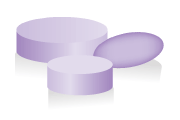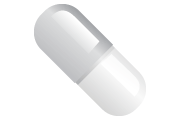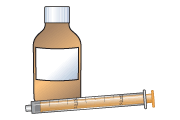Hydroxycarbamide for sickle cell disease
This leaflet is for parents and carers about how to use this medicine in children. Our information may differ from that provided by the manufacturers, because their information usually relates to adults. Read this leaflet carefully. Keep it somewhere safe so that you can read it again.
Name of medicine
Hydroxycarbamide (hydroxyurea)
Brand Name: Siklos® Hydrea®
This leaflet is about the use of hydroxycarbamide for sickle cell disease.
Why is it important for my child to take hydroxycarbamide?
Normal red blood cells are doughnut-shaped but in sickle cell disease they are sickle-shaped (like a crescent moon) and do not move through the blood vessels as well as normal. Your child probably has episodes of severe pain that last for a few days (sickle cell crisis), and may need frequent blood transfusions. Hydroxycarbamide may reduce the number of sickle cell crises your child has, and the number of times they need a blood transfusion.
What is hydroxycarbamide available as?
Tablets: 1 g
Capsules: 500 mg; these contain small amounts of lactose
Liquid medicine: 500 mg in 5 mL; this can be ordered specially from your pharmacist
When should I give hydroxycarbamide
Hydroxycarbamide is usually given once each day, this is usually in the morning.
Give the medicine at about the same time each day so that this becomes part of your child’s daily routine, which will help you to remember.
How much should I give?
Your doctor will work out the amount of hydroxycarbamide (the dose) that is right for your child.
The dose will be shown on the medicine label. Your doctor will start with a low dose and then increase it gradually every 12 weeks to find the lowest dose that works for your child.
It is important that you follow your doctor’s instructions about how much to give.
How should I give hydroxycarbamide?

Tablets
- Tablets should be swallowed with a glass of water, squash or juice. Your child should not chew the tablet.

Capsules
- Capsules should be swallowed with a glass of water, squash or juice. Your child should not chew the capsule.

Liquid medicine
Measure out the right amount using a medicine spoon or oral syringe. You can get these from your pharmacist. Do not use a kitchen teaspoon as it will not give the right amount.
When should the medicine start working?
It may take a few months for the medicine to start working. It is very important that you continue to give the medicine to your child during this time. Your doctor will decide whether it is helping once your child has been taking it for about 3 or 4 months.
What if my child is sick (vomits)?
- If your child is sick less than 30 minutes after having a dose of hydroxycarbamide, give them the same dose again.
- If your child is sick more than 30 minutes after having a dose of hydroxycarbamide, do not give them another dose. Wait until the next normal dose.
If your child is sick again, seek advice from your family doctor, nurse, pharmacist, or hospital. They will decide what to do based on your child’s condition and the specific medicine involved.
What if I forget to give it?
Give the missed dose when you remember during the day, as long as this is at least 12 hours before the next dose of hydroxycarbamide is due.
Never give a double dose of hydroxycarbamide.
What if I give too much?
If you think you may have given your child too much hydroxycarbamide, contact your doctor or local NHS services (111 in England and Scotland; 111 or 0845 4647 in parts of Wales) or take your child to hospital. Take the medicine container or packet with you, even if it is empty. This will be useful to the doctor. Have the packet with you if you telephone for advice.
It can be dangerous to give too much hydroxycarbamide.
Are there any possible side effects?
We use medicines to make our children better, but sometimes they have other effects that we don’t want (side effects).
Side effects you must do something about
If your child is short of breath or is wheezing, or their face, lips or tongue start to swell, or they develop a rash, they may be allergic to hydroxycarbamide. Take your child to hospital or phone for an ambulance straight away.
If your child gets ulcers on their skin, lips or mouth, or peeling skin or nails, contact your doctor straight away.
If your child seems to bruise more easily or bleeding doesn’t stop as quickly as you would expect, there may be a problem with their blood clotting. Contact a doctor or take your child to hospital straight away.
Other side-effects you need to know about
Your child may get some of the following side effects when they first start taking hydroxycarbamide. These usually wear off after a few days as your child gets used to the medicine. If they are still a problem after a week, or you are worried, contact your doctor but continue to give hydroxycarbamide.
Your child may have stomach pain, feel sick (nausea) or be sick (vomit). Giving the medicine with some food or milk may help. They may also have diarrhoea (runny poo) or constipation (difficulty doing a poo).
They may get headaches.
Your child may get a tingling or feeling of numbness in their hands and feet. If this happens discuss it with your doctor at your next visit.
Your child’s hair may become thinner and some may fall out. It should grow back when the medicine is stopped. Discuss this with your doctor at your next visit.
Your child may sometimes get side-effects that are not listed above. Contact your doctor if you notice anything unusual or are concerned. You can report suspected side-effects to www.mhra.gov.uk/yellowcard.
Can other medicines be given at the same time as hydroxycarbamide?
You can give your child medicines that contain paracetamol or ibuprofen, unless your doctor has told you not to.
Hydroxycarbamide should not be taken with some common drugs that you get on prescription. It is important to tell your doctor and pharmacist that your child is taking hydroxycarbamide.
Check with your doctor or pharmacist before giving any other medicines to your child. This includes herbal or complementary medicines.
Is there anything else I need to know about this medicine?
If your child comes into contact with anyone who has chicken pox or shingles, you should contact your doctor straight away, as they may need special preventative treatment.
If your child comes into contact with anyone who has measles, even if your child has had the MMR injection, contact your doctor as infections can be more severe.
Your doctor will test your child’s blood regularly to check whether the medicine is working and to check it has not affected their kidneys, liver or blood.
Hydroxycarbamide affects your child’s immune system so they may get more infections such as chest infections, coughs and colds, and they may take longer than usual to fight these off. They may also become ill very quickly, in which case you should contact your doctor.
Hydroxycarbamide may harm an unborn baby. If your daughter is sexually active, it is very important that she uses adequate contraception to prevent unplanned pregnancy. The oral contraceptive pill can be used safely in woman or girls taking hydroxycarbamide. If your daughter is worried that she may be pregnant, it is important that she sees your family doctor as early as possible. She should keep taking her medicine until she sees her doctor.
You may have read that scientists were concerned that hydroxycarbamide might cause leukaemia. However, long-term research has shown that taking hydroxycarbamide will not make your child more likely to get leukaemia. It is quite safe to give your child hydroxycarbamide for sickle cell disease.
General advice about medicines
- Try to give medicines at about the same times each day, to help you remember.
- If you are not sure a medicine is working, contact your doctor but continue to give the medicine as usual in the meantime. Do not give extra doses, as you may do harm.
- Only give this medicine to your child. Never give it to anyone else, even if their condition appears to be the same, as this could do harm.
- Make sure that you always have enough medicine. Order a new prescription at least 2 weeks before you will run out.
- Make sure that the medicines you have at home have not reached the ‘use by’ date on the packaging. Give old medicines to your pharmacist to dispose of.
If you think someone else may have taken the medicine by accident, contact your doctor straight away.
Where should I keep this medicine?
- Keep the medicine in a cupboard, away from heat and direct sunlight.
- It does not need to be kept in the fridge.
- Make sure that children cannot see or reach the medicine.
- Keep the medicine in the container it came in.
Who to contact for more information?
Your child’s doctor, pharmacist or nurse will be able to give you more information about hydroxycarbamide and about other medicines used to treat sickle cell disease.
England: NHS 111
Tel 111
www.nhs.ukScotland: NHS 24
Tel 111
www.nhs24.scotNorthern Ireland: NI Direct
Wales: NHS 111 Wales
Tel 111
www.111.wales.nhs.ukSickle Cell Society
020 8961 7795
www.sicklecellsociety.org/Copyright disclaimer
Version [1]. © NPPG, RCPCH and WellChild, all rights reserved. Review by August 2016.
The primary source for the information in this leaflet is the British National Formulary for Children. For details on any other sources used for this leaflet, please contact us through our website, www.medicinesforchildren.org.uk.
We take great care to make sure that the information in this leaflet is correct and up-to-date. However, medicines can be used in different ways for different patients. It is important that you ask the advice of your doctor or pharmacist if you are not sure about something. This leaflet is about the use of these medicines in the UK, and may not apply to other countries. The Royal College of Paediatrics and Child Health (RCPCH), the Neonatal and Paediatric Pharmacists Group (NPPG), WellChild and the contributors and editors cannot be held responsible for the accuracy of information, omissions of information, or any actions that may be taken as a consequence of reading this leaflet.
